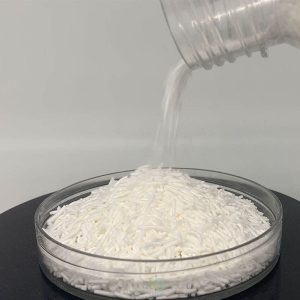
Sodium Lauryl Sulfate SLS

Specifications
| Item | Index | |
| Active Matter %≥ | 92 | 95 |
| Petroleum ether soluble substances %≤ | 1.5 | 1.5 |
| Inorganic salts(NaCl+Na2SO4) %≤ | 5.5 | 5.5 |
| Water %≤ | 2.5 | 2.5 |
| PH(1% aq.solution) ≤ | 7.5-9.5 | 7.5-9.5 |
| Whiteness(WG)≥ | 90 | 90′ |
Packing & Storage
| Packing | in 20 or 25kg bag |
| Storage | 20℃, 2 years. |
| Shipping | Room temperature in China; may vary elsewhere |
Free Quote
At present, the company has more than 10 experienced export sales .
For samples, pricing, or more information, please call us at 0086-25-52397805 or mail to info@ascent-chem.com or we will respond to you as soon as possible.
Tel: 0086-25-52397805
E-mail: info@ascent-chem.com

General Information
| Common Names | Sodium lauryl sulfate | Sodium dodecyl sulfate | K-12 | Lauryl sulfate sodium salt | ||||||
| Structure | |||||||
| CAS No. | 151-21-3 | Boiling Point (℃) | N/A | ||||
| Molecular Weight | 288.38 | Melting Point (℃) | 206ºC | ||||
| Appearance | White powder or White Needle | Vapor Specific Gravity | 0.25 | ||||
| HS Code | 34021100 | Flash Point (℃) | >100ºC | ||||
| Solubility | Soluble in water | Autoignition Temperature (℃) | |||||
| Safety Phrases | |||
| RIDADR | |||
| WGK Germany | |||
| Packaging Group | |||
| Hazard Class | |||
| SYMPTOMS | PREVENTION | FIRST AID | |
| Inhalation | Cough. Sore throat. | Use local exhaust or breathing protection. | Fresh air, rest. |
| Skin | Redness. Burning sensation. Itching. | Protective gloves. | Remove contaminated clothes. Rinse and then wash skin with water and soap. |
| Eyes | Redness. Pain. | Wear safety goggles. | First rinse with plenty of water for several minutes (remove contact lenses if easily possible), then refer for medical attention. |
| Ingestion | Abdominal pain. Nausea. Vomiting. | Do not eat, drink, or smoke during work. Wash hands before eating. | Rinse mouth. Induce vomiting (ONLY IN CONSCIOUS PERSONS!). Refer for medical attention . |

Frequently Asked Questions
Q: Application of Sodium Lauryl Sulfate?
Sodium Lauryl Sulfate SLS has good emulsifying properties, foaming properties, water solubility, biodegradability, alkali resistance, hard water resistance, stability in aqueous solutions with a wide pH value, easy synthesis, and low price. It has been widely used in cosmetics, detergents, textiles, papermaking, lubrication, pharmaceuticals, building materials, chemicals, oil extraction and other industries. It can also be used in the properties of positive and negative ion surfactant compound systems, micellar catalysis, molecular orderly combination body and other basic research.
Q: The dangers of sodium lauryl sulfate?
Health Hazard: Irritating to mucous membranes and upper respiratory tract, irritating to eyes and skin. May cause an allergic reaction in the respiratory system.
Explosion hazard: This product is flammable, irritating and sensitizing. Combustible in case of open flame and high heat. Decomposed by high heat releases toxic gas.
Hazardous combustion products: carbon monoxide, carbon dioxide, sulfide, sodium oxide.
Surfactant with strong degreasing ability, so it is often used in facial cleanser. Long-term use due to excessive cleaning ability and high irritation will seriously reduce skin defense ability, resulting in immature epidermal cells and loose structure, making the surface The thinning of the cortex is susceptible to external stimuli and keratin alienation, causing a series of problems such as fragility and sensitivity, enlarged pores, dull skin, acne, aging, etc.!
Q: The contact treatment?
Skin contact: Take off contaminated clothing and rinse with plenty of running water.
Eye contact: Lift the eyelids and rinse with running water or saline. Seek medical attention.
Inhalation: Get away from the scene to fresh air. If breathing is difficult, give oxygen. Seek medical attention.
Ingestion: Drink plenty of warm water, induce vomiting. Seek medical attention.
Fire extinguishing method: Firefighters must wear gas masks and full-body fire suits, and put out the fire in the upwind direction.
Extinguishing agent: mist water, foam, dry powder, carbon dioxide, sand.
Q: Spill emergency treatment?
Emergency treatment: isolate the leaked contaminated area and restrict access. Cut off the fire source. It is recommended that emergency personnel wear dust masks (full face masks) and protective clothing. Avoid raising dust, sweep it up carefully, put it in a bag and transfer it to a safe place. If a large amount of leakage occurs, cover it with plastic sheeting or canvas. Collect and recycle or transport to waste disposal site for disposal.
Q: Operation precautions?
Airtight operation, strengthen ventilation. Operators must undergo special training and strictly abide by the operating procedures. It is recommended that operators wear self-priming filter dust masks, chemical safety protective glasses, anti-poison infiltration overalls, and rubber gloves. Keep away from fire and heat sources, and smoking is strictly prohibited in the workplace. Use explosion-proof ventilation systems and equipment. Avoid generating dust. Avoid contact with oxidants. When handling, load and unload lightly to prevent damage to packaging and containers. Equipped with corresponding types and quantities of fire-fighting equipment and leakage emergency treatment equipment. Empty containers may be harmful residues.
Q: Disposal method?
Refer to relevant national and local regulations before disposal. Disposal by incineration is recommended. Sulfur oxides from the incinerator are removed through a scrubber.

